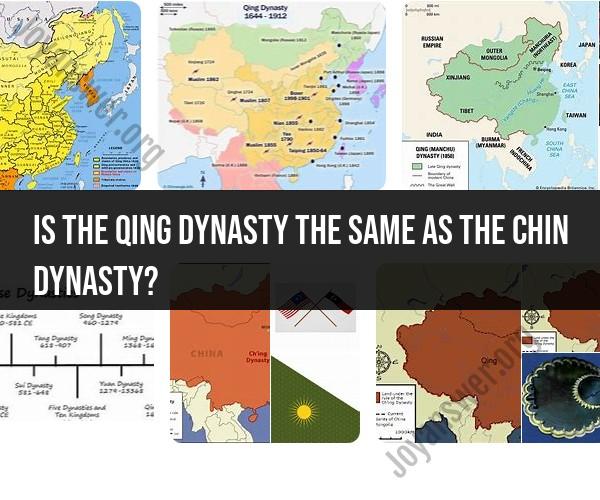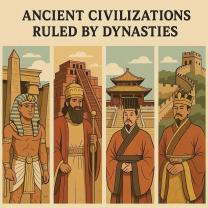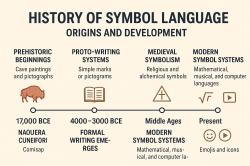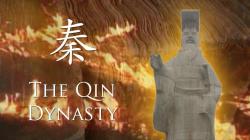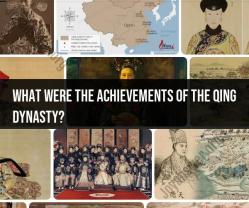Is the Qing dynasty the same as the Chin Dynasty?
No, the Qing Dynasty and the Qin Dynasty are not the same; they are two distinct dynasties in Chinese history with significant differences in terms of time period, rulers, culture, and impact on China.
Time Period:
Qin Dynasty (221-206 BCE): The Qin Dynasty was the first imperial dynasty of China, founded by Qin Shi Huang after he successfully unified several warring states. It marked the beginning of China's imperial era.
Qing Dynasty (1644-1912 CE): The Qing Dynasty was the last imperial dynasty of China, established by the Manchu people who overthrew the Ming Dynasty. It ruled China for nearly three centuries until the early 20th century.
Rulers:
Qin Dynasty: The Qin Dynasty was founded by Qin Shi Huang, who is known for standardizing various aspects of Chinese culture and governance, including the writing system and measurements. He is also famous for building the Great Wall of China and the Terracotta Army.
Qing Dynasty: The Qing Dynasty had multiple emperors during its rule, with the first being Emperor Shunzhi and the last being Emperor Puyi. The Qing Dynasty was a Manchu-led dynasty, with Manchu rulers and a distinct Manchu culture.
Cultural and Political Differences:
Qin Dynasty: The Qin Dynasty is known for centralizing political power, establishing a unified system of government, and implementing legalistic policies. It standardized writing and measurement systems, which contributed to the cultural and linguistic unity of China.
Qing Dynasty: The Qing Dynasty adopted Confucianism as the state ideology and ruled over a vast and culturally diverse empire. It expanded China's territory significantly, including territories in Tibet, Mongolia, and Central Asia. The Qing Dynasty also saw the flourishing of Chinese art, literature, and culture.
Legacy:
Qin Dynasty: While the Qin Dynasty was relatively short-lived, it laid the foundation for imperial rule in China and left a lasting legacy in terms of governance, administrative structures, and cultural developments.
Qing Dynasty: The Qing Dynasty was one of the longest-reigning dynasties in Chinese history. Its legacy includes both positive and negative aspects. It contributed to the expansion of Chinese territory but also faced challenges like foreign invasions and internal unrest, leading to its eventual downfall in the early 20th century.
In summary, the Qin Dynasty and Qing Dynasty are distinct in terms of time period, rulers, cultural influences, and historical impact on China. The Qin Dynasty marked the beginning of imperial China, while the Qing Dynasty was the last imperial dynasty before the establishment of the Republic of China.
Qing Dynasty vs. Chin Dynasty: Key Differences
| Qing Dynasty | Chin Dynasty |
|---|---|
| Years | 1644-1912 |
| Founder | Nurhaci |
| Ethnic group | Manchu |
| Capital | Beijing |
| Major achievements | Unification of China, expansion of territory, cultural flourishing |
China's Historical Dynasties: Distinguishing Qing from Chin
The Qing Dynasty was the last imperial dynasty of China, lasting from 1644 to 1912. It was founded by the Manchus, a Tungusic-speaking ethnic group from Manchuria. The Qing Dynasty was a time of great expansion for China, as the empire reached its greatest territorial extent under the reign of the Kangxi Emperor. The Qing Dynasty was also a time of great cultural flourishing, as the Manchus adopted and adapted Chinese culture while also introducing their own unique elements.
The Chin Dynasty was the first imperial dynasty of China, lasting from 221 to 206 BC. It was founded by Ying Zheng, the king of the Qin state, who unified China under his rule and declared himself the first emperor of China. The Chin Dynasty was a time of great change and innovation, as the Qin emperors implemented a series of reforms to standardize weights and measures, construct the Great Wall of China, and unify China under a single legal code.
The Qing and Chin dynasties were two of the most important dynasties in Chinese history, but they were also very different in many ways. The Qing Dynasty was a foreign dynasty, founded by the Manchus, while the Chin Dynasty was a native Han Chinese dynasty. The Qing Dynasty was also a much longer-lasting dynasty than the Chin Dynasty, and it experienced a period of great cultural flourishing.
Dynastic History: Exploring the Contrasts Between Qing and Chin
One of the most striking contrasts between the Qing and Chin dynasties is their ethnic origins. The Qing Dynasty was founded by the Manchus, a Tungusic-speaking ethnic group from Manchuria, while the Chin Dynasty was founded by Ying Zheng, the Han Chinese king of the Qin state. The Manchus were a nomadic people who had a very different culture from the Han Chinese. However, the Qing rulers were quick to adopt and adapt Chinese culture, and they eventually became assimilated into the Han Chinese population.
Another key difference between the Qing and Chin dynasties is their longevity. The Qing Dynasty lasted for over 260 years, while the Chin Dynasty lasted for only 15 years. The Qing Dynasty's longevity was due in part to the fact that it was a foreign dynasty. As such, the Qing rulers were able to maintain a tight grip on power and prevent rebellions. The Chin Dynasty, on the other hand, was a native Han Chinese dynasty. This meant that the Chin rulers had to contend with the same kinds of internal conflicts that had plagued previous dynasties.
Finally, the Qing and Chin dynasties also differed in terms of their cultural achievements. The Qing Dynasty was a time of great cultural flourishing, as the Manchus adopted and adapted Chinese culture while also introducing their own unique elements. The Chin Dynasty, on the other hand, was a time of great change and innovation, but it was not a time of great cultural flourishing. The Chin emperors were more focused on expanding and consolidating their empire than on promoting cultural development.
In conclusion, the Qing and Chin dynasties were two of the most important dynasties in Chinese history, but they were also very different in many ways. The Qing Dynasty was a foreign dynasty, founded by the Manchus, while the Chin Dynasty was a native Han Chinese dynasty. The Qing Dynasty was also a much longer-lasting dynasty than the Chin Dynasty, and it experienced a period of great cultural flourishing.
